|
California’s
Fall Classic
The Everest Challenge/Furnace Creek 508 Double
When the
Everest Challenge moved to a fall slot a couple of years ago,
it stacked arguably to two toughest public (no qualifier) bike
races in the world on top of each other, and thus opened
another epic fitness challenge to the world.
Back
To Steve's Page
|
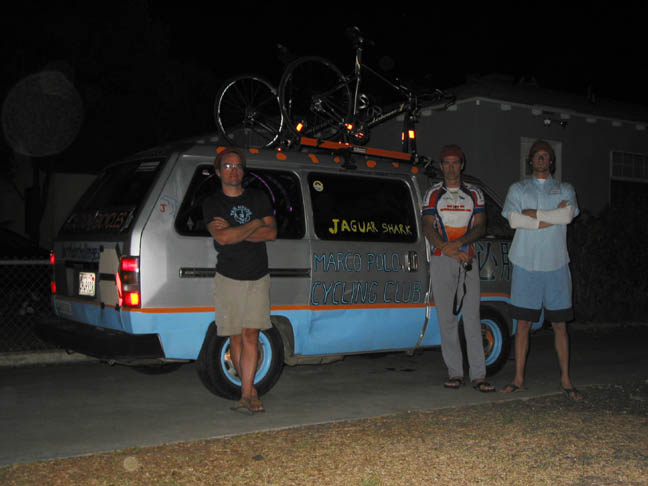
|
|
The
Everest Challenge is a two-day stage race with 30,000 feet of
climbing (actually 29-whatever-the-height-of-Everest-is) and
is considered to be the toughest race on the USCF calendar.
The 508 is, well, 508 miles. This should speak for itself but,
just in case it doesn’t, the organizers have mapped a course
through some of the most blighted countryside in the USA along
with 35,000’ of climbing. As my friend Josh, a one-time
denizen of this territory put it, “almost every day of the
year a wind blows from southwest to northeast, which will be
in your face for hundreds of miles. The roads are terrible,
and the people driving them are worse. Not many of the
tweaked-out meth heads you’ll encounter out there would
think twice about killing you.” This intrigued me enough to
hatch a hair-brained scheme: attempting these two races back
to back.
Actually, I
didn’t plan it that way. The idea for the 508 came in
August, when my friend Russ McBride told me he was opting for
it instead of Everest and tried to get me to do the same.
“Maybe I’ll try both,” I said completely off the cuff,
since up until then Furnace Creek has held little interest for
me. “I’ll bow down to your greatness if you can pull that
off,” was Russ’ reply.
Everest
Challenge
Furnace Creek 508
This is the
part where I should add that I’d never even ridden a double
century. Of course, lack of preparation has never been one to
put me off. In fact, I thrive on it. Still, I didn’t enter
the 508, preferring instead to see how Everest went before
making what I was pretty certain was a stupid commitment.
Unfortunately,
it filled-up the week before Everest, prompting me to contact
Chris Kostman, the race direction, and plead for a spot. After
a cancellation I was in. This meant I had to pony up my 300
clams, and was committed, prior to having any clue as to
whether I could even finish part one of the challenge.
Part I: The Everest
Challenge
I’ve been
curious about the Everest Challenge ever since Aaron Baker
sent me a “let’s do this” email a few years back. At 180
pounds, I’m a lot more a crit guy than climber but, still,
riding up hill on a bike is one of my favorite activities. So
much so, in fact, that no uphill challenge with a stout
reputation doesn’t linger in the subconscious to the point
of obsession. Fargo
St, Black Canyon, L’Alpe
d’Huez, the
7 Samurai, Double
Figueroa, etc. If it’s rumored to be hard, I want to
have a look. And nothing is rumored to be as hard as Everest.
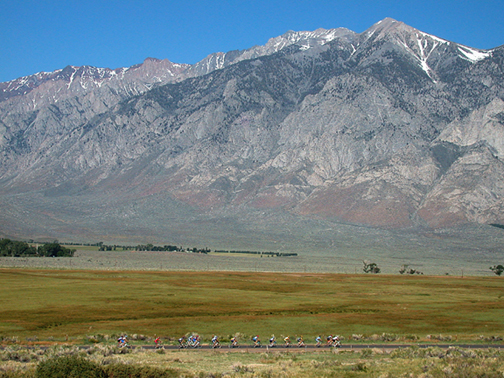
Aaron is a much
better climber than I am and his DNF hung over me like the
Sword of Damocles. As did a few other “race” reports I
found scattered throughout the web. Pro riders “paper boying”
in 27’s, “barely turning my cranks over”, and having
“never felt so fat at 141 pounds in my life” had me scared
to say the least. Local rider Dotsie
Cowden won the women’s division last year and promptly
ended her season. “Stick a fork in me, I’m done,”
started her journal entry that included being derided by her
(super strong) boyfriend for talking him into such an event.
Russ tried hard to get me to join him last year. I declined,
having nowhere near the requisite miles, but his DNF fueled
the fire a bit more.
Not enough
to train, however. Instead I went climbing. Rock climbing.
Riding isn’t my primary sport. At times I ride a lot. At
others, I ride to work and/or to bars. Winter 2005 was all
about climbing: no racing, no training. But a late spring
finger injury coupled with heavy snow pack in the Sierra
(meaning the alpine climbing season would be short) forced a
re-focus. Back on my bike and plodding up hills with my friend
Jacinda’s breakfast club (basically long rides centered
around eating) I started to find some form. Perhaps this would
be the year to give her a shot.
Training, of sorts
But “the
plan” (quotes because it wasn’t much of a plan) had a few
hooks on it. First, it wasn’t going to be scientific.
Second, it wasn’t going to interfere with my participation
in other sports. I made exactly zero of our club’s rides, an
auspicious start. I didn’t wear my heart rate monitor once.
Training consisted of one long day on the weekend at first,
then two. The workweek centered around recovery rides and
maintenance climbing workouts. I know a ton about training but
instead decided for the more Zen approach, basing everything
entirely on feel. My weekend workouts got longer and longer, and
then even longer. A couple of weeks before Everest I
decided to try and race, so I did three crits in a day—more
as a joke than anything else. Losing my fifth try for a prime,
it was obvious I wasn’t very fast. However, I was able to
keep trying for them, meaning I was fit. So at least I had
that going for me.
Life: as it should be
On the
drive up to Bishop, I happened upon the Still Life Café, in
Independence. This French bistro had opened in Olancha (middle
of nowhere) and was instantly hailed as the best food between
LA and Tahoe. But it had, not surprisingly, gone out of
business a while back. Apparently, however, they’d only
moved and I wasn’t in on it. Seeing their sign was like
spotting land from a life raft. I hustled inside, where
you’re greeted by a world not a bit like, well,
Independence, California. Chatting with the owners over a Cote
de Rhone, life was as it should be. Michele, the owner,
lamented about the eastern Sierra culinary abyss. “They
serve food like… well… like you would get in prison. And
you pay just as much as here!”
This
just had to be a good omen.
Or not…
Hours later, after a prison dinner in Mammoth, I was awaked by
something crashing into the house where I was staying.
Somehow, Hurricane Rita had found her way west and had been
pasting us all night long. Unable to get back to sleep, I
turned on the weather channel. Snow down to 9,000. Winds up to
45mph, worsening throughout the weekend. On my way to the
start my car’s thermometer told me it was 37 degrees at
Tom’s Place. Calculating somewhere between the adiabatic and
environmental lapse rates meant it was approximately 20
degrees at Mosquito Flat. Good thing I’d been training in
the heat.
|
|
pics:
right: self portait prior to EC start. way too early, way too
cold, way too tired.
above: the neutral start to everest. we pretty much climb
everything in site.
top: team zissou, pre 508, a bit hungover, perhaps?
Day 1
The race
starts with a long neutral zone. It was chilly, but not
freezing. More importantly, it wasn’t windy at all. I rode
with a stack of clothing expecting the worst and most of it was
off by the time we truly started climbing.
The true race
begins and the Paradise Café. I, however, was way too worried
about finishing to race and immediately lost the pace of the
leaders and somehow found myself alone for the majority of the
first climb. This seemed like a good idea as I’d heard many a
tale of someone over extending to stay in the draft only to
explode later on.
|
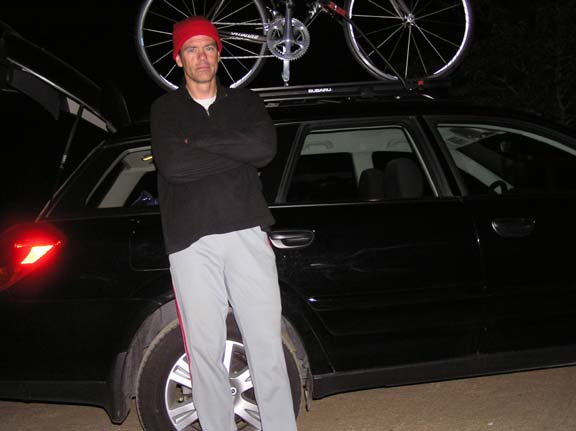
|
Mosquito Flat
While this
climb is over 20 miles long, it’s broken up a bit with one
significant downhill and fairly continues sections that are
quite easy. My pace was strictly pedestrian. At the top I
stopped, ate, and stretched. People were asking if I was okay.
“Fine,” I’d answer. “Just riding scared.” And it
wasn’t cold. The weather was pretty much perfect.
Was last night just a dream?
I cruised
down the descent until I was caught by a group of pros (who’d
started an hour behind). Then I used my extra weight to tag
along for a while until they began to hammer on the flats. There
would be none of that for me. At the aid station I stopped again
whereas most people were racing, I guess, as they’d do a
standard feed zone exchange as if it was a three-hour affair.
Shoot, we’d already been out over three hours and were just
getting started!
Pine Creek
An “easy”
10 from the feed zone according to race organizer Tom Reid, the
top of Pine Creek sure did approached slowly. This time,
however, I’d found some company with a very-fit-looking women
who was riding “as a tourist”. We chatted with riders
passing us, who all seemed quite jovial, but our non-competitive
nature seemed to bug some of those we’d pass.
At the top,
the carnage was beginning. One rider who’d passed me on the
first climb looked like he was about to pass out. “I can’t
believe how hard this is,” he gasped to everyone. All of us
tried to assure him we were suffering as well.
I took
another planned pit stop at my car. I wasn’t sure that I
needed it but was playing it safe. Aaron had told me that, in
reality, the start of the final climb was half way. So I
stopped, took off my shoes, stretched, ate, and talked to a
couple of folks running support for family members.
South Lake
20 miles of
grimness, everyone talks about how horrible this climb is at
this stage in the day. It wasn’t about to disappoint. I felt
okay, so far, and thought maybe I was in for a bit of luck.
Then I felt a
twinge in my knee. I
slowed to a crawl, got to the next aid station, and stopped
again. The knee didn’t hurt too badly, but I was worried. If
it became inflamed I’d be screwed. Better to go slow and
steady. Soon I was back with Pam, my partner from the last
climb. Her knee was bothering her as well and we took turns
“pulling” each other at what felt like 3 mph. Funny thing
is, we were passing people.
The last 10k
eases off and, knowing I’d make it, I picked it up ever so
slightly. I lost Pam and caught a couple of others before the
final 2k that features three ramps up the 17%. My goal was not
to walk and I made it, just barely. At one point I told someone
on the side of the road that I was just working on my track
stand. I’m pretty sure you can’t go any slower on a bike.
The first
thing that crossed my mind at the top was something Pam had
said. “You finish the first day and you think there’s just
no possible way that you can do it again. But somehow you do.”
I wondered if she was sandbagging. How would I possibly do this
again tomorrow?
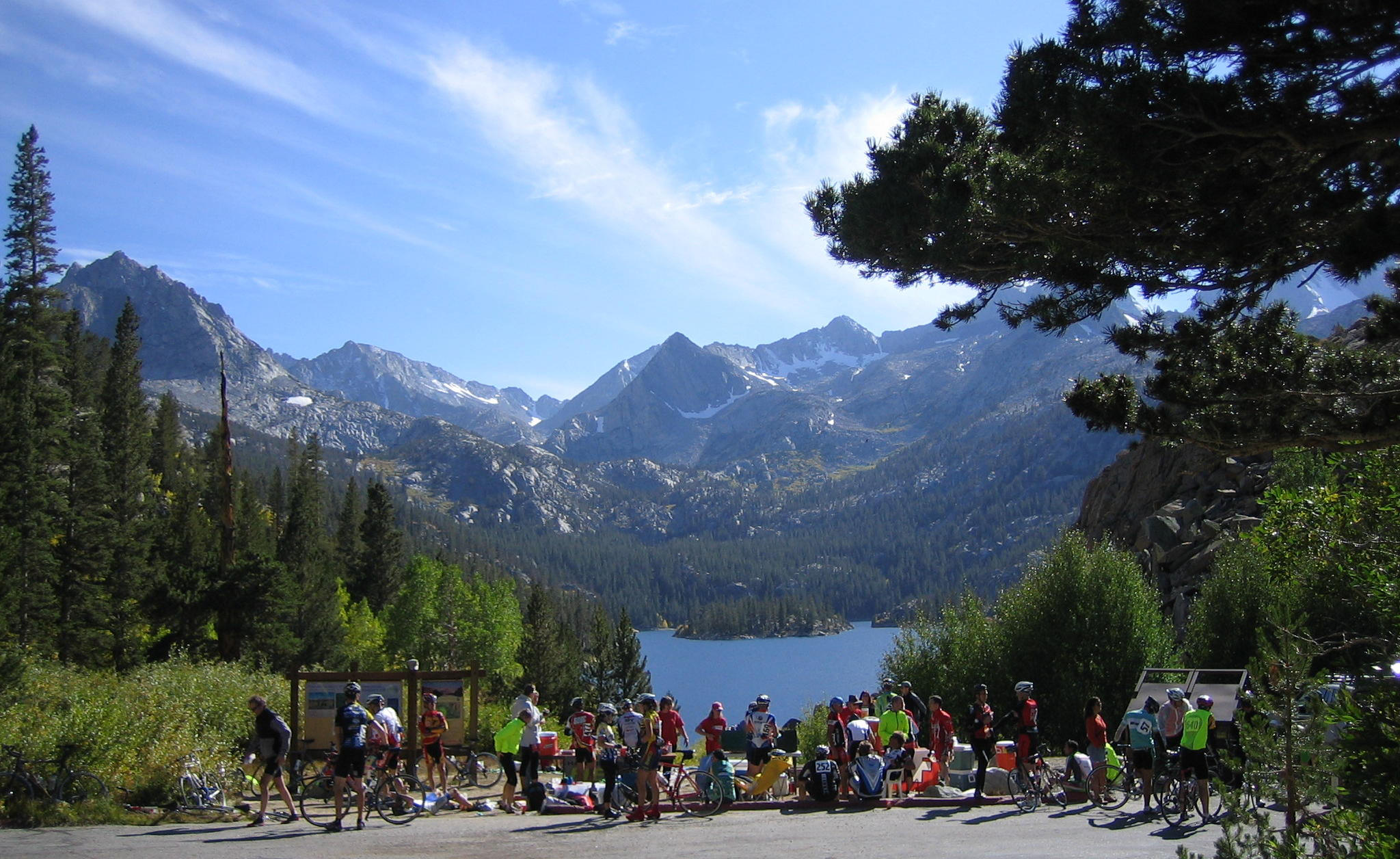
celebration
at the end of day one
While icing
my knee, I found out that Pam had actually won the race, so
she’d done a lot more than just finish day two. This gave me
confidence to look at the standings. In my division, I was in 3rd,
13 minutes down. In a race like this, 13 minutes is like 13
seconds.
|
Day 2
I felt good
at the start, at least until my knee started to hurt while still
in the neutral zone! I immediately slowed, lost the pack, and
all thoughts of racing ceased. It didn’t matter much anyway.
Overnight, two new people had somehow showed up in our division
and both were close to an hour in front. But the point was to
finish, which was—for the moment—in jeopardy.
Glacier Lodge
This climb
may have the profile of Alpe d’Huez but it certainly doesn’t
have the panache. L’Alpe is stunning with its 21 famed hairpin
turns. Glacier Lodge is a straight 10% slog up arid terrain.
Near the top the scenery improves and the angle decreases. My
knee had survived and I picked up the pace a bit. Because the
next climb was easy, I was going to make the final climb, at
which point I’d walk if I had to. This meant I could race a
bit. Caught up with buddy Pete—the guy 13 minutes ahead—near
the summit and we descended together.
Wacova
I stopped at
my car to re-fuel, letting Pete ride ahead. His girlfriend,
Julie, was giving him on the road support, which was pretty
common. Most of the racers had team cars and treated this like a
normal race. As insane as this seemed to me earlier, it was
starting to make sense. My stops were costing me a lot of time
and I’d regularly pass the same people over and over.
I caught Pete
a bit later. We had a tailwind on Wacova and I was feeling
pretty good, except for my knee. Julie gave me some ibuprofen,
which seemed to help. I eventually rode away from Pete, feeling
a little guilty since he’d provided the means for me to do so.
On the way down, made another pit stop at my car, and started
the final climb feeling strangely good.
Oh,
yeah, also saw a guy descending pulling his kid. Was someone
really doing the Everest Challenge with a kid? Oh my God! If so,
heroes are to be found in the strangest places.
Schulman Grove
Weather
conditions had been perfect until this climb so, in a way, it
was nice to be tested. Still, the headwind that hammered us ride
up Westguard pass was rugged. But I felt fine. There was no
question about finishing anymore.
The fun part
of this section was watching the pro race as they started to
catch me. At one point, on about an 8% grade, a pack of four
riders came by—and they were taking pulls! It was so
ridiculous that it almost made me want to puke. A guy I was
about to catch, Tom, jumped on their wheel for about a second,
which made me laugh out loud since I’d considered the same
thing until I realized that if I spent even a minute attached to
that group it would seriously diminish my chance of finishing.
This climb
levels off in the middle for a fairly long stretch. I caught
some more riders and then kept my streak alive of stopping at
every aid station. This time it was pure procrastination,
although I knew the toughest section of the race was ahead and
wanted to stretch my knee. It hurt, but I didn’t care. I was
going to finish the Everest Challenge even if I had to walk.
The last 10k
are seriously hard. Averaging over 10%, and that’s with a
downhill, it features sustained 15% climbing and finishes at
over 10,000’. A couple of guys passed me in triples. I
commented to a guy I was passing that I wished I’d had one.
“I wish I had a quadruple,” he muttered. It’s really hard
to deem this sort of thing ‘racing’.
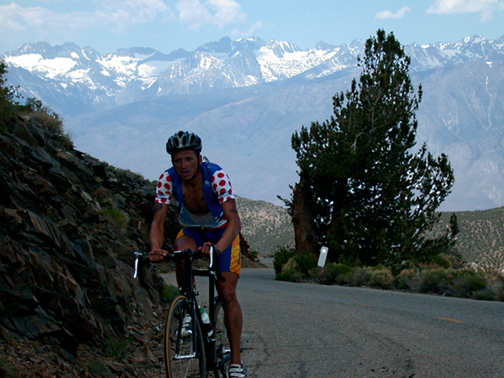
no spotted jersey
for me. some other (probably fast) guy at the last bit of the
race.
I was happy
to see the summit, finish, eat burritos and enjoy the view.
I’d taken enough time from Pete to win my division from the
day before—except for the two new guys. But none of this
mattered. Next year, maybe I’d race it. For now, this was
mission accomplished. No matter how you do it, if you finish
it’s a stunning couple of days of bike riding.
The only
bummer was the lack of an awards ceremony. There was supposed to
be something back at the start but things didn’t seem to be
going smoothly at all and folks were just packing up and
leaving. Pete and I agreed that we doubted anyone would have any
trouble pitching in 10 bucks for, at least, some beer. After
spending a couple of days suffering together, we’d really
earned a little celebration.
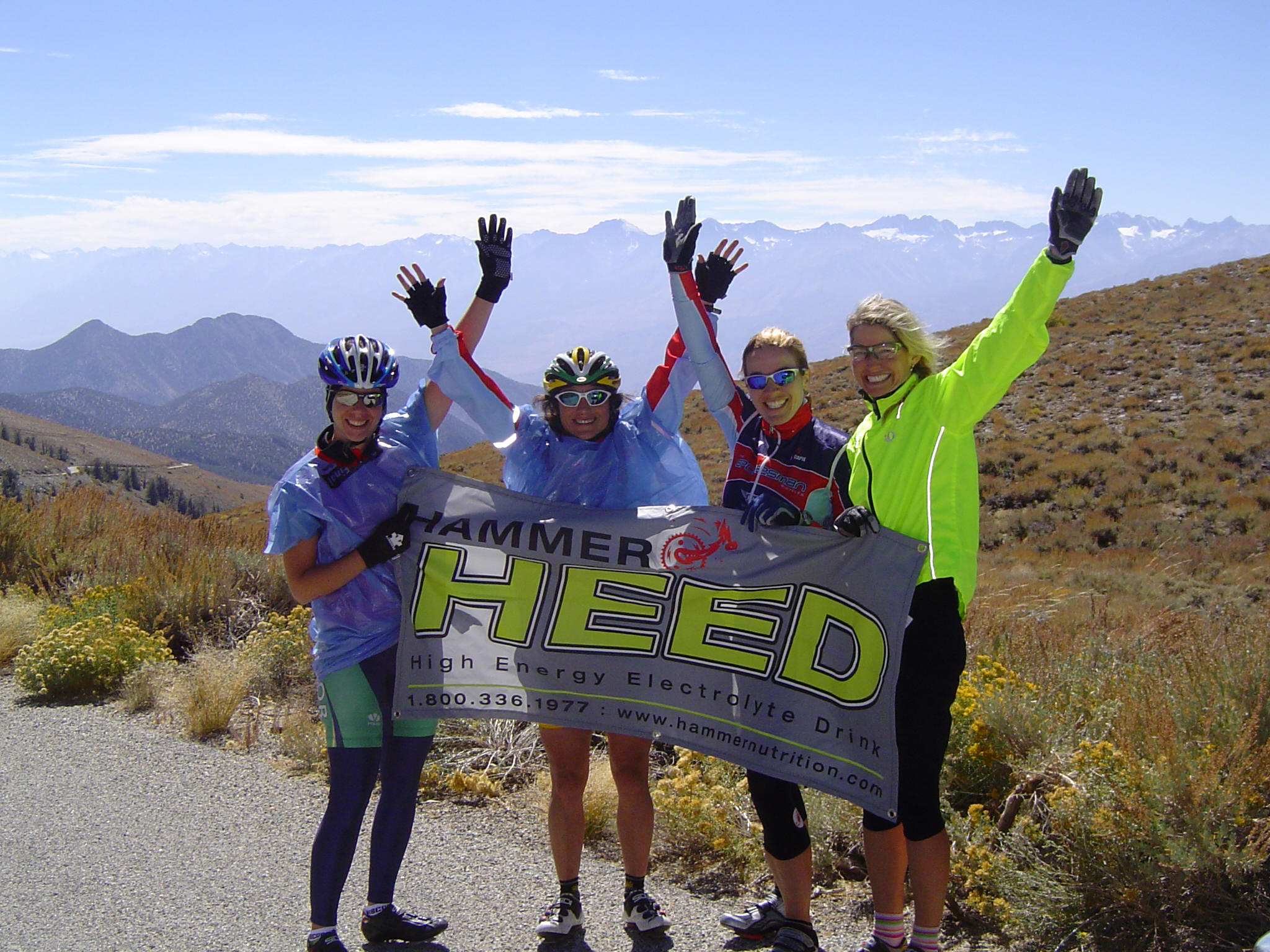
women's
"podium", place holder whilst waiting for pete to send
me our photos
After a beer
(I was stocked, of course) Pete and Julie had to get back to
Colorado right away, so they headed east and I heading south, to
the Still Life, ‘cause I was living life as it should be.
|
Part II: The Furnace Creek 508
With my knee the way it was, I
wouldn’t have entered the 508 at this point. On my drive home,
I called Josh to see if he wanted to do it as a team instead. He
said sure.
But the next day my knee
didn’t really hurt. At least sitting at my desk. I figured
that this meant in two weeks I’d be fine, or at least fine
enough. So I dusted off my time trial bike and gave it its first
spin of the year. Since I’d spend much of the 508 on this
machine, I knew this wasn’t the prep the event deserved. So
not only was I doing it in off-the-couch style, I was attempting
it in injured, off-the-couch style—okay, this looks a lot
stupider now that it’s written down. Surely, I thought, soft
pedaling 500 miles couldn’t be that hard….
|

|
Team Jaguar Shark
No matter
what, part two of this cliffhanger was going to be fun, and an
adventure. First, I had to choose a totem to race under, which
had to be an animal. Jaguar shark was the first thing that
popped into my head. Wasn’t sure it existed, but some had
eaten Esteban. With scriptgirl Ann-Marie bowing out—she
didn’t like our course as it traveled through unprotected
lands—our team was now three strong. No problem with that.
Intern # 1.
Josh Fairchild. Expert rider. Ex-desert dweller. Mechanic.
Drunk. He would be the brains behind Team Jaguar shark.
Intern #2.
Bob Banks. Expert birthday challenger. Navigator. Frogman. Knows
nothing about bikes but a lot about beer. Partner on many an
epic adventure. Born
on the Puget Sound.
The Zissou.
Me. Right on the edge. I could go either way. “Intern, get me
a Campari.”
|

|
|
This was our
desert team. Back on my island, we assembled a top-notch crew to
ready our team van, Klaus. Always the B team leader, with over
330,000 miles on the original engine, nothing could be more
faithful.
Reed
Bartlett. Our groundman for this adventure. Mechanic. Imbiber.
Boy are we gonna drink a lot of beer.
Angela
Sandoval. Josh’s wife. Artist. The real brains behind the
team, what would we do without her in the wastelands? Commented
Josh, “who’s going to tell us about all the bike parts and
everything? You know I can’t remember all that shit.”
The
decoration of Klaus went like clockwork. By the end, Klausy was
a thing of beauty. Sure, the bearing casings shouldn’t look
like that, but we couldn’t afford to fix them this year. We
painted the insignia’s of everyone who’s driven the team van
for a long time period on each of the four corners: Esteban,
Bob, Josh, Reed. We were ready.
|
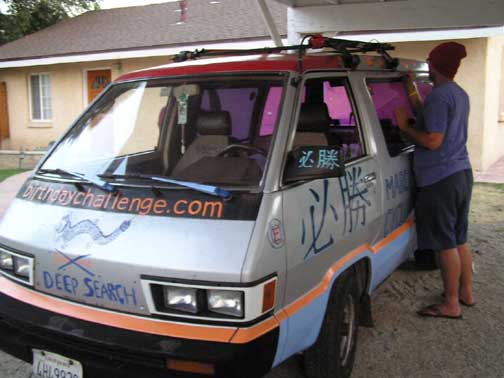
|
Pre-race Meeting
The list of
rules for the 508 is absurdly long. We all tried to read them
but couldn’t and were worried about getting DQ’d before we
even started. Thankfully, things weren’t as strict in reality
as on paper but we might have pushed our luck when we bribed the
waiter to score some wine at the pasta feed. We, of course,
were the only ones drinking. “How do they expect us to eat
without wine?” said the exasperated Josh.
Even though
the meeting was fairly tedious, the event was looking pretty
cool. Riders were there from around the world, most treating it
similar to us, or so it seemed. My friends Russ and Jen Long
were there. Russ “hadn’t been riding much." Jen had
been hit by a car the week before and her knee was swollen to
twice its normal size. Talking to a guy from Team Tahiti about
how they could train for such an event, he commented, “we
expect to be strong in the swim.” Guess I wasn’t the only
one going into this thing half-cocked.
Later, Russ
called to remind me to bring him an extra saddle. When he heard
we were drinking he sounded incredulous. “Really?” he said,
which must have been overheard by Bob and Josh who yelled out
“he knows who your crew is. Ferchrissakes, what else do you
expect us to be doing?”
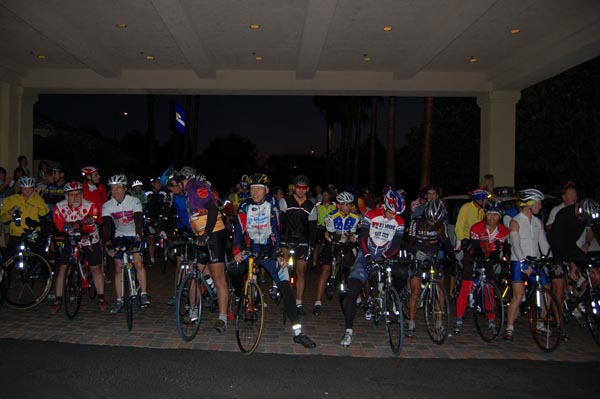
|
Unprotected Lands
“I wonder
if we can switch to a relay team mid race,” crossed my mind
around mile 8, or as soon as the course began to head up hill.
The knee hadn’t really improved, or so it seemed, and I still
had 500 miles to go. The race began with a 20-mile climb with
one, short, 10% section. I could tell I was in trouble but had
no choice but to try and soft pedal and push on.
pics:
josh begins working on klausy
ang: artist and brains of the outfit
reed: groundman, imbiber
at the start line
bob, as always, ready for action
the start of the race is very conversational
|
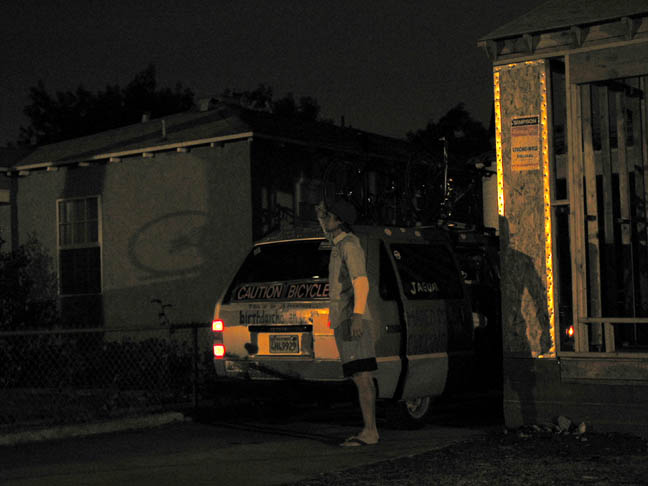
|
|
This meant my pace would be
talkative, and everyone around me seemed enjoying it. We
weren’t supposed to ride together but given it was just the
beginning, traffic wasn’t light, and we were going up hill no
one seemed to mind. I was riding with Russ and our birthday
challenge kit got some comments. All was well until,
fortunately, I took a pit stop just before Russ and the rest of
our group got directed the wrong way. This led to a 40-minute
detour for them, a lot of it uphill. I’m sure Russ was bitter,
especially since one rider in the group called his team car and
got a lift back to the course. Huh? Mabye we should have read
all those rules! I hit this fork alone and ended up pulling out
my map. It seemed like a very easy mistake to make.
|
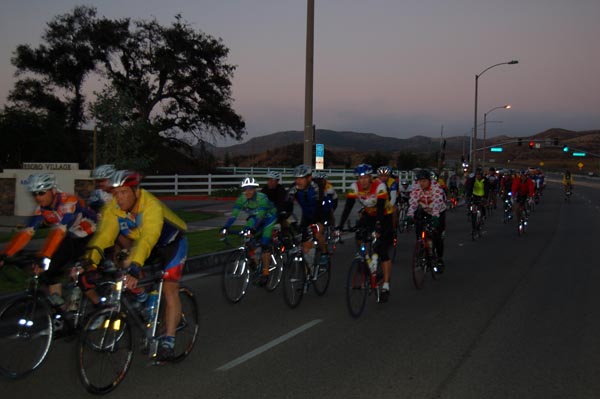
|
|
In the desert
I switch to my time trial bike. When I mentioned the knee, Josh
said “don’t worry about it. It’ll be fine.” Well, okay
then. And on I rode.
The windmill
climb was straight into the wind and I crept up it at a snails
pace. I had employed a in and out of the saddle trick to
distribute pressure to different muscle groups, which helped my
knee a lot. On this climb it was so windy it didn’t work as
well. Either that or it was getting worse.
After the
descent, I switched bikes again and headed towards “beautiful
oasis of California City,” which I knew from hearing Eric
Estrada pitch real estate on late-night TV. I guess I missed it,
since I passed the “California City” checkpoint in some
forgotten wind-blasted town of sand, mesquite, and a couple of
strip malls.
eric estrada:
"you too can own beautiful california real estate!"
|
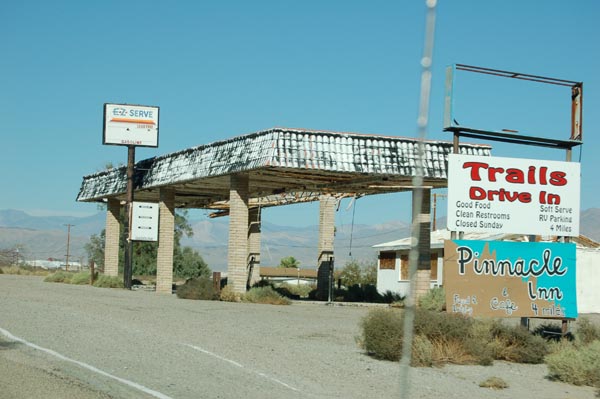
|
|
Into the depths of the Mojave:
boy, there sure was a lot of traffic. Along with the cross
winds, it made this section down right scary. I don’t know
what these people are all doing since there’s nothing out
here, but they were in a rush to do it. Find more meth, maybe?
And, in spite of what was obviously be an event they didn't seem
to want to slow down or heed the signs “pass with care.” My
deep rims caught the wind like a sail.
This can be a good thing for speed but, when hit at the
right angle, it would try and rip the bike from under me. The
passing trucks (quite sure they don’t sell anything other than
trucks out here) made this effect worse, so I opted to hammer
through this section as fast as I could. I passed a bunch of
people but was paying a price. Each time a gust of wind would
hit me from the side, the force I needed to exert felt like
someone was sticking a knife into my knee. I wasn’t about to
worry about it. Laying the bike down out here meant I was in the
crosshairs of these idiots as potential road-kill. I felt like a
character in The Road Warrior.

low on
fuel? run someone off the road. wez, load the crossbow. we
need some gas.
|
|
At the turn towards Randsburg,
things finally quieted down. The wind was at my back. The knee
felt better, and it wasn’t hot at all. I decided to ignore the
knee totally--just keep fueling, riding, and enjoying the views.
Mighty pretty country in these parts. Landlocked.
During one long and fast
descent, somewhere between Red Mountain and Trona, I had a big
scare. My bike started to shudder and, thinking it was a
puncture, I tried to ease onto the brakes. This caused the
shuddering to get worse and worse and I was worried I’d lose
control before I was able to stop. It got so bad I was eyeing
the dirt next to the road for a good place to ditch. I finally
stopped and didn’t have a flat. I checked the bike. Nothing.
Cautiously starting to descend, everything seemed fine. I weaved
back and forth, bunny-hopped, tested the brakes, nothing. Was I
losing it mentally already?
A bit later I
got my answer. I was now on a flat section. I had a slight
tailwind. It was calm and quiet. All of a sudden I saw some
rocks and sand fly across the road in front of me. Before I
could think of much I was sandblasted in the back and the bike
shuddered wildly. Again, I thought I was going down. A dust
devil had hit me, for a second time. From now on, I’d be
careful about letting go of my bike with both hands.
|
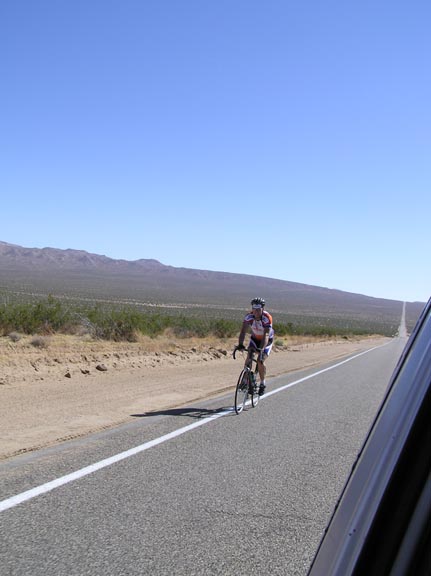
|
|
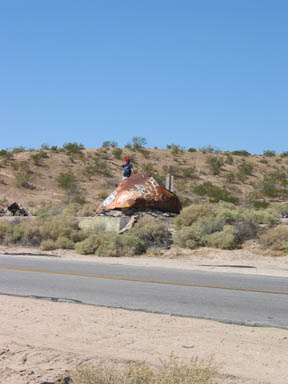
|
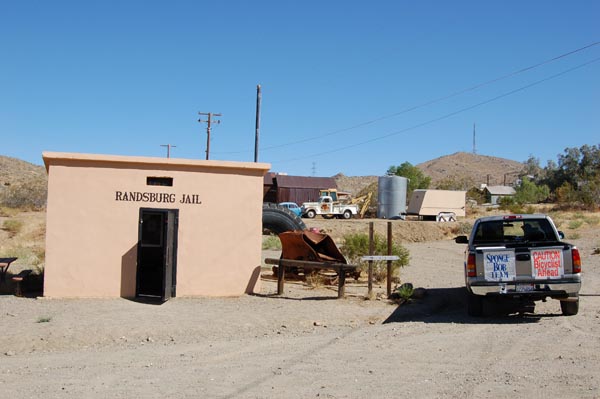
|
|
Trona
Thing began
to unravel in Trona. I felt good when I got there but getting
off my bike it was hard to walk. Hmm. I took a break and iced my
knee.
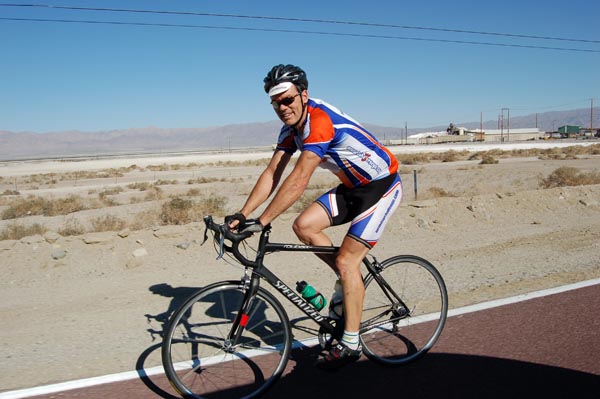
|
|
pics:
way above, the long lonely climb into randsburg. pretty country.
landlocked.
josh
having an alien encounter. common in these parts.
randsburg
jail/torture chamber. probably a good place to shed some of this
weight.
outside
of trona. if not for this knee, things would be peachy.
descending
into the panamint valley.
Other than
that, things were going great. Though in cruise mode, I was only
an hour and twenty minutes behind the leaders. Also, I was
speeding up since I was an hour down at the first checkpoint.
Steve Born,
of Hammer Nutrition, had
sent me his nutrition plan from his double 508 (yes, that’s
right, he did it in both directions) and it was working
perfectly. No cramping. No stomach issues. I had no saddle
problems yet, felt strong, and hadn’t felt the need to change
clothes or clean up. All good signs.
|

|
|
Team Jaguar
Shark had been exemplary as well. I had no idea how much work
they would have to do but feeding me, keeping the bikes ready,
etc, was a big job. It seemed like I was seeing them constantly
even though we were playing leap frog. At night, they’d have
to follow me the entire time, which seemed pretty grim. But they
weren’t complaining. In fact, they seemed to be enjoying it.
So I rolled
out towards Towne’s Pass, while the team fueled up for the
night. We’d see no more services for almost 200 miles. All was
good until the next hill, which wasn’t steep, but was killing
the knee. A shame, really, since the weather was perfect, the
scenery was nice, and the roads empty.
The team
caught me and we tried some tape and ibuprofen. I’d been using
naproxin sodium and it wasn’t working. At this point, a switch
couldn’t hurt. Down into the Panamint Valley I was making good
time, however, Towne’s Pass was looming and I knew I was going
to have to make a decision.
right:
a rough stretch of pavement in the panamint valley.
below:
looking up towards towne's pass
|
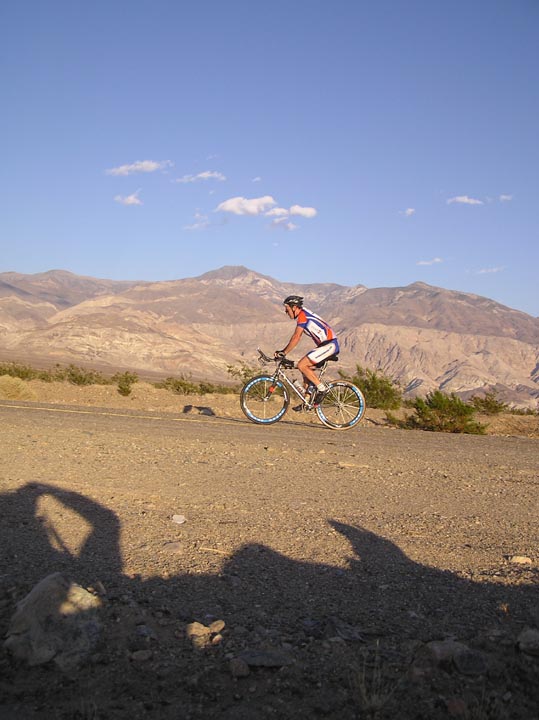
|
|
I made Towne’s just as the sun
was setting. Perfect. Just over 200 miles in about 12 hours.
That had been my goal. What wasn’t so perfect was that I’d
been kicking around the plusses and minus’ of continuing and
it wasn’t looking good. Could I finish? Maybe. Would it be
worth it? The thought of being out for six month of rehab
wasn’t pleasant. I really dislike being injured. I think
people dislike me when I’m injured too.
Team Jaguar Shark always makes
the best of a bad situation. Bob handed me a beer. “You can
start now, but you might as well give it a shot.” Looking up
we could see a parade of red lights creeping their way up the
mountain. A very cool site. Sure. Of course I’d try to go on.
|
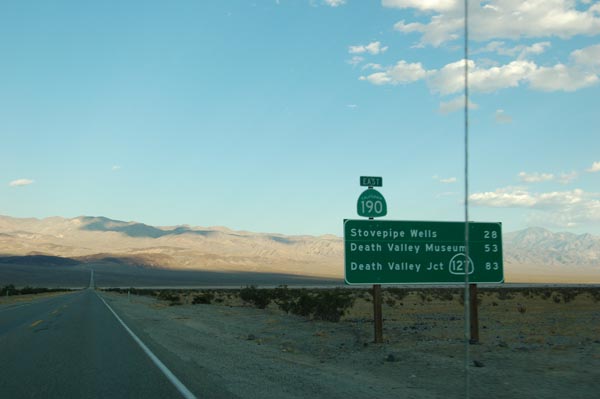
|
|
Halfway
up the climb I called it quits. It was a tough decision. For
one, the wind was blowing out of the northeast. It was bad now,
but it meant the likelihood of a tailwind throughout the night.
I also knew that if I crested Towne’s, it was downhill for a
long way and I’d be committed to Salisbury Pass at which point
I might be close enough to the end I might start getting summit
fever—a condition where you start to make less logical
decisions. If I was going to make a rational decision to stop,
it had to be now. After the summit, it was possible that only
serious injury would stop me and the knee was definitely
worsening all the time.
The
Interns were game for me to continue on until I proposed the
“what if I can’t ride all winter” scenario. This
particularly alarmed Josh, one of my main riding partners.
“Yeah, you should quit. I’ll bet we can find a bar still
open.”
According
to the official, I was making the right decision. A buddy of his
rode through knee pain to win the race-across-something or other
and wound up ruining his knee to the point where "he still
can't ride well". (Later, Steve Born told me more or less
the same thing, that dropping out was the right move. His
brother had done the same thing this year.) It was just what I
needed, since the longer I sat there the more I wanted to get
back on the bike. It's amazing how hard it is to be rational in
these kind of events.
|
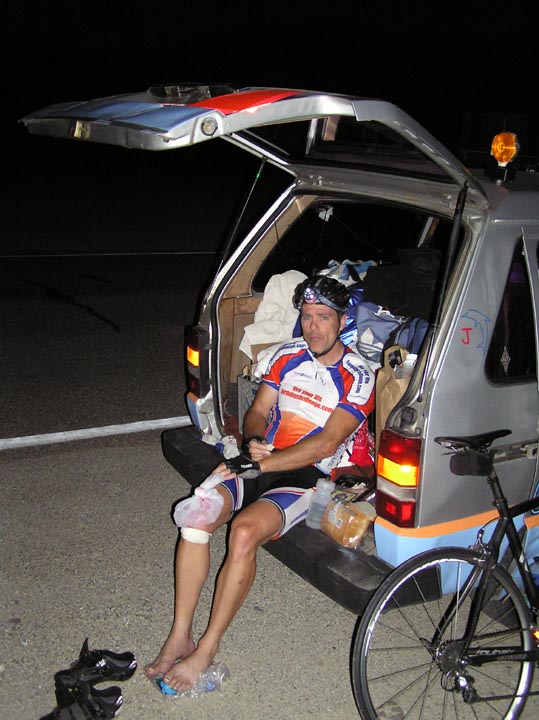
|
|
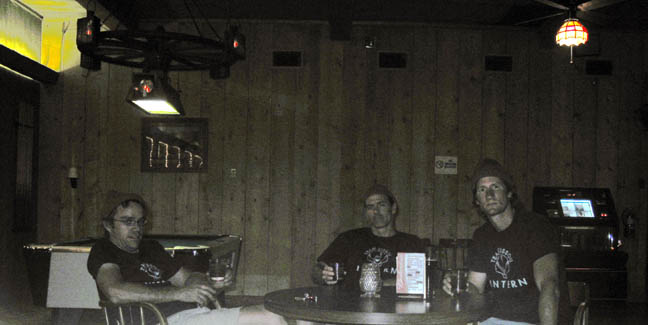
A short time
later we were in Stovepipe Wells Saloon. We were in luck, they
had Campari in stock. And thus, we began to ponder the
question, “what’s next for Team Zissou?”
Post script:
Russ and Jen both made it to nearly mile 400. Russ’ lesson
would be to take in more electrolytes as he seriously bonked
during the night. Jen’s was “don’t get his by a car the
week before the race.” Mine, I guess, would be either train
more or don’t do the Everest Challenge first.
Tips and
stuff
-
We agreed that this race would be more fun as a team.
This way, the driving and riding is all done by the same people.
It’s not the same challenge, but you can go fast and you
don’t have to feel guilty about how bored your support crew
is.
-
More training than I did would be helpful if you planned
to really race, but I did some things right. The best thing was
nutrition. I only consumed around 300 calories and hour on
average with some additional “meals” like sandwiches. Most
of the cals were an assortment of bars, gels, bananas. On my
bike I’d always have a bottle of water and a bottle of sports
drink, either HEED, Accelerade (some protein is important), or
Cytomax. Mainly I like to switch for flavor. The same of
anything gets old. Each hour, I would take a pack of between 3-6
(depending on heat) endurolytes, 1 race cap, 1 anti fatigue cap,
1 mito-r cap. Every three hours I’d take: 1 race cap, 1 anti
fatigue, 1 mito r, and 1 AO cap. It’s possible I’ve never
felt better in a long event.
-
Bikes. A time trial and climbing bike combo is the
best. I’m certain Tinker would have won the race if he had a
TT set-up. It’s a huge advantage over this course. The
combination will save a good rider an hour, an average rider
even more time.
-
A triple,
while hardly necessary, would help on the climbing bike (maybe
not for relays). Like in Everest, the ability to spin and save
your muscles is huge. On Towne’s Pass, not many people were
spinning well.
- An
automatic is better for the vehicle. Klaus is a stick. Not only
that, he’s old. We were joking going up Towne’s as to
whether my knee or the van would die first. Driving 3mph up hill
is not easy with a clutch, especially with a 20-year-old car.
- I
didn’t really get to test this but I think having different
seating positions would help over the long haul. My TT and
climbing bike are very different and each time I switched I was
very comfortable for a little while, at least.
- Also,
my feet hurt, so next time I think I’ll bring some toe straps
so I’ve got the option of riding in trainers for a break.
- It’s
important to realize that riding slow is much better than not
riding at all, so any tricks that might keep you on your bike
should be considered. Tinker’s team brought a full suspension
mtn bike. They didn’t use it, but if you’ve got the room,
always opt for anything extra that you might use.
- I
could have used a cortisone shot, but I’m not sure I’d
recommend that.
|
|